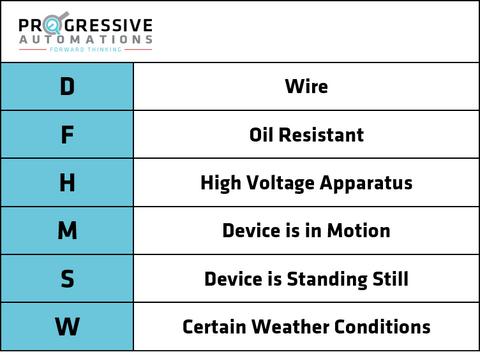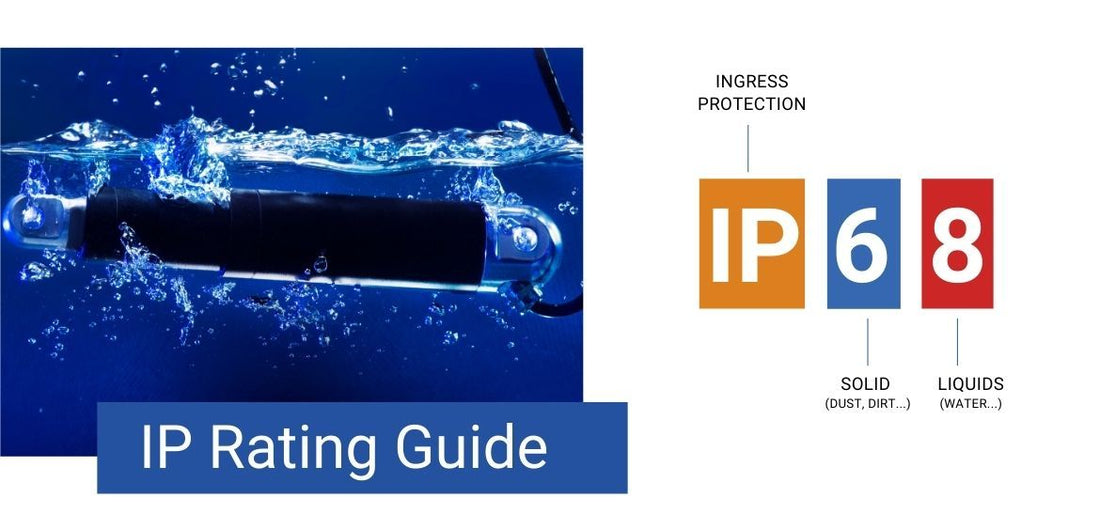Some of the most frequently asked questions we receive is to do with IP protection and ratings. What does an IP rating mean? What are the different IP ratings? How does the rating system work? We understand there are many questions regarding this topic, so to help you understand it better, we have created this guide.
IP rating meaning
An International Protection Marking, also known as IP Rating/Code, is the rating of a product’s ability to withstand liquid and dust intrusion. Defined by IEC/EN 60529, the standard was developed by the International Electrotechnical Commission and is recognized all over the world.
The IP rating system uses a 2-digit system to define its protection rating for all products. The first digit represents protection against solids and the second against liquids. The IP Code was designed to standardize protection ratings and limit misinterpretation/misrepresentation of a product's protection ability.
IP Rating Table
Once a product has completed testing at an approved facility, it will achieve a specific numeric rating which can be deciphered using the IP rating chart below:

What Do the IP Rating Numbers Mean?
First Digit
The dust protection (first digit) can have a value from 1 to 6. As this number increases, the product's ability to withstand foreign objects/dust ingress increases. For example, a product that has a rating of IP2X can withstand foreign objects up to 12.5mm or greater in size, whereas an object with a rating of IP6X is dust tight. “X” is used to designate a specific area where the product has not been tested.
Second Digit
The liquid protection (second digit) follows the same format but can have a value from 1 to 8. As the number increases, protection from liquid ingress increases. Units with an IPX4 rating can withstand water spray for a continuous 5 minutes. As the chart indicates, there are specific angles, pressures, and volume requirements that must be followed during the test. The stringent testing procedure of the IP rating system ensures standardization between testing facilities around the world.
Extra Letters
Sometimes, there might be a letter at the end of the code IPXX. This is the supplementary letter, and it can be used to denote the supplementary information from the product standard. Please check out the chart below for more information:

Multiple IP Ratings on One Product?
Some products can have multiple IP ratings, such as cellular devices. A common rating is IP55/IP57. This means that the unit was not able to pass the IPX6 liquid ingress test. If a unit lists only one rating, it indicates that it has passed all tests up to and including the specific number which is displayed. Sometimes there is a rating IP68M and IP69K, which means it passed both tests.
How Are Progressive Automations’ Products Tested?
All Progressive Automations’ linear actuators are tested under the Ingress Protection standards by IEC (International Electrotechnical Commission). Our linear actuators range from IP20 all the way up to IP69K. The PA-18 Track Linear Actuator and the PA-08 Mini Track Linear Actuator both have a rating of IP20 as they both have open shaft housings, which would allow water to enter into the unit. This illustrates when a unit can hold against foreign objects but has zero protection against liquid.
Units rated for IP66, like the PA-04 Linear Actuator and PA-09 Mini Industrial Actuator, are able to withstand both dust and liquid ingress. The PA-10 has the highest IP rating in our range, with IP68M and IP69K. It can operate underwater and is able to withstand high-pressure water jets when it’s not in motion.
Water Resistance Testing
Water resistant testing is achieved by water sprayed from 3 meters, with a 12.5mm nozzle, for 3 minutes. This is an unusual and unlikely real-world application; however, this type of rating typically tests a unit for use in outdoor applications. It is important to understand that units, which are approved for outdoor use, may not be able to handle extreme weather conditions such as very high/low temperatures and situations which involve strong waves/pressure washing.
However, IP69K is rated for high-pressure, high-temperature wash-down conditions. It has been designed to handle the most extreme conditions. Another note is that the IP Code does not test for outdoor/weather resistance during seasonal changes and for long periods of time (e.g., years outside during multiple seasons).
All Progressive Automations’ linear actuators are designed and tested for stationary protection. When the actuator is in motion, the strokes can pull water into the shaft housing, allowing water to penetrate the DC motor which can cause irreparable damage. It is important not to operate actuators when they are wet/damp to avoid any type of water damage. However, for the PA-10 model, it has an IP rating of IP68M, which means the actuator is able to operate underwater and has water ingress protection.
Final Word
With the International Protection Marking chart, linear actuators and other products can be chosen to suit many different applications with confidence and an understanding of the products' true ability. It is important to choose an appropriately rated linear actuator for its intended environment and any potential hazards that may arise. If you would like any additional information on our products and their IP ratings, please reach our customer sales team at sales@progressiveautomations.com.




